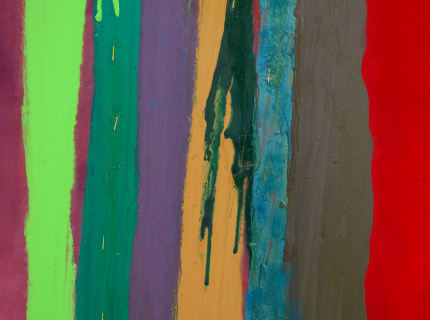Frank Bowling: Make It New
Alexander Gray Associates presented its first exhibition of work by Frank Bowling OBE, RA (b.1934), Frank Bowling: Make it New. Born in British Guiana, Bowling maintains studios in London and New York. For over five decades, his practice has been defined by its integration of autobiography and postcolonial geopolitics into abstraction. Featuring a selection of recent work, the presentation celebrated Bowling’s contributions to the field of painting.
Bowling first came to prominence in the early 1960s while still a student at the Royal College of Art in London. Graduating at the height of the British Pop movement, his early work combined representation with gestural applications of paint. After moving to New York in 1966, he immersed himself in post-war American art, producing his semi-figurative Map Paintings (1967–71) before fully embracing abstraction with his series of Poured Paintings (1973–78). A talented and incisive writer, he became a contributing editor to Arts Magazine, drafting insightful texts on artistic production and race. Friends with artists like Melvin Edwards and Jack Whitten, Bowling was also mentored by the art critic Clement Greenberg, and the formal innovation of his practice builds on the legacy of Abstract Expressionism and Color Field Painting.
In recent work, Bowling continues to hone his approach to abstraction. Playing with color and texture, he synthesizes more than a half-century of painterly techniques. Expanding on the dynamic swaths of acrylic of his 1970s Poured Paintings, these intricate compositions juxtapose gestural drips and slides of pigment against collaged surfaces that refine the accreted roughness of the artist’s 1980s reliefs. Through the use of printed canvas, fabric, and seams, Bowling recalls his mother—a dress designer, embroiderer, and general store owner—incorporating autobiography into the formalist rigor of abstraction.
At the same time, in paintings like Elder Sun Benjamin (2018), which features stacked planes of color, Bowling evokes the presence of both horizons and borders. Inviting comparisons to the Romantic landscapes of Turner and the striped compositions of Barnett Newman and Jasper Johns, these works imbue abstraction with allusions to observed reality, inviting discourses on the natural world and the complex intertwining of geography and territory. However, Bowling insists, “I do not want to illustrate anything, but to make the paint dance. … The paint does its own thing, spreads and bleeds and then suggests images.” Reveling in color and geometry, Frank Bowling reveals the artist’s masterful ability to “make the paint dance” as he continues to question the nature of abstraction and the possibilities of painting.
A major retrospective of Bowling’s work organized by Tate Britain, London, United Kingdom will open in 2019.


